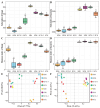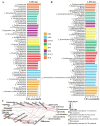Local Fungi Promote Plant Growth by Positively Affecting Rhizosphere Metabolites to Drive Beneficial Microbial Assembly
- PMID: 40871256
- PMCID: PMC12388802
- DOI: 10.3390/microorganisms13081752
Local Fungi Promote Plant Growth by Positively Affecting Rhizosphere Metabolites to Drive Beneficial Microbial Assembly
Abstract
Ecological restoration in the cold and high-altitude mining areas of the Qinghai-Tibet Plateau is faced with dual challenges of extreme environments and insufficient microbial adaptability. This study aimed to screen local microbial resources with both extreme environmental adaptability and plant-growth-promoting functions. Local fungi (DK; F18-3) and commercially available bacteria (B0) were used as materials to explore their regulatory mechanisms for plant growth, soil physicochemical factors, microbial communities, and metabolic profiles in the field. Compared to bacterial treatments, local fungi treatments exhibited stronger ecological restoration efficacy. In addition, the DK and F18-3 strains, respectively, increased shoot and root biomass by 23.43% and 195.58% and significantly enhanced soil nutrient content and enzyme activity. Microbiome analysis further implied that, compared with the CK, DK treatment could significantly improve the α-diversity of fungi in the rhizosphere soil (the Shannon index increased by 14.27%) and increased the amount of unique bacterial genera in the rhizosphere soil of plants, totaling fourteen genera. Meanwhile, this aggregated the most biomarkers and beneficial microorganisms and strengthened the interactions among beneficial microorganisms. After DK treatment, twenty of the positively accumulated differential metabolites (DMs) in the plant rhizosphere were highly positively associated with six plant traits such as shoot length and root length, as well as beneficial microorganisms (e.g., Apodus and Pseudogymnoascus), but two DMs were highly negatively related to plant pathogenic fungi (including Cistella and Alternaria). Specifically, DK mainly inhibited the growth of pathogenic fungi through regulating the accumulation of D-(+)-Malic acid and Gamma-Aminobutyric acid (Cistella and Alternaria decreased by 84.20% and 58.53%, respectively). In contrast, the F18-3 strain mainly exerted its antibacterial effect by enriching Acidovorax genus microorganisms. This study verified the core role of local fungi in the restoration of mining areas in the Qinghai-Tibet Plateau and provided a new direction for the development of microbial agents for ecological restoration in the Qinghai-Tibet Plateau.
Keywords: beneficial microorganisms; ecological restoration; local fungi; promoting plant growth; rhizosphere metabolites.
Conflict of interest statement
The authors declare no conflicts of interest.
Figures







Similar articles
-
Co-analysis of cucumber rhizosphere metabolites and microbial PLFAs under excessive fertilization in solar greenhouse.Front Microbiol. 2022 Oct 6;13:1004836. doi: 10.3389/fmicb.2022.1004836. eCollection 2022. Front Microbiol. 2022. PMID: 36274730 Free PMC article.
-
Rhizobacteria from vineyard and commercial arbuscular mycorrhizal fungi induce synergistic microbiome shifts within grapevine root systems.Sci Rep. 2025 Jul 30;15(1):27884. doi: 10.1038/s41598-025-12673-5. Sci Rep. 2025. PMID: 40739286 Free PMC article.
-
Combined application of sheep manure and organic fertilizer improves soil quality and microbial community structure and function in alpine mining areas.Microbiol Spectr. 2025 Sep 2;13(9):e0084025. doi: 10.1128/spectrum.00840-25. Epub 2025 Aug 5. Microbiol Spectr. 2025. PMID: 40762497 Free PMC article.
-
Management of urinary stones by experts in stone disease (ESD 2025).Arch Ital Urol Androl. 2025 Jun 30;97(2):14085. doi: 10.4081/aiua.2025.14085. Epub 2025 Jun 30. Arch Ital Urol Androl. 2025. PMID: 40583613 Review.
-
Systemic treatments for metastatic cutaneous melanoma.Cochrane Database Syst Rev. 2018 Feb 6;2(2):CD011123. doi: 10.1002/14651858.CD011123.pub2. Cochrane Database Syst Rev. 2018. PMID: 29405038 Free PMC article.
References
-
- Feng Y., Wang J., Bai Z., Reading L. Effects of surface coal mining and land reclamation on soil properties: A review. Earth-Sci. Rev. 2019;191:12–25. doi: 10.1016/j.earscirev.2019.02.015. - DOI
-
- Ge H., Feng Y., Li Y., Yang W.L., Gong N. Heavy metal pollution diagnosis and ecological risk assessment of the surrounding soils of coal waste pile at Naluo Coal Mine, Liupanshui, Guizhou. Int. J. Min. Reclam. Environ. 2016;30:312–318. doi: 10.1080/17480930.2015.1050840. - DOI
Grants and funding
LinkOut - more resources
Full Text Sources
Research Materials

